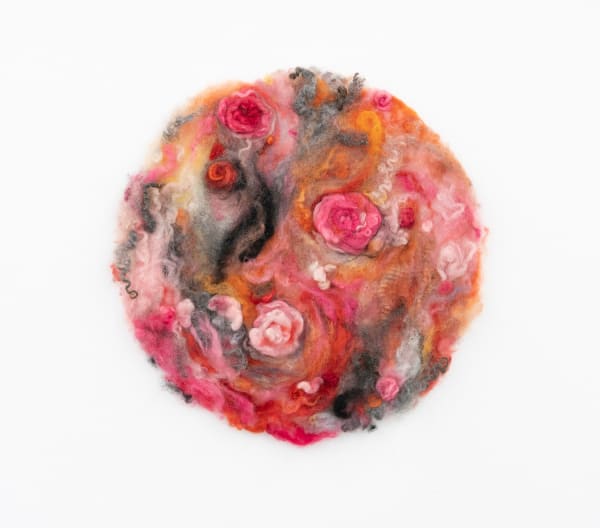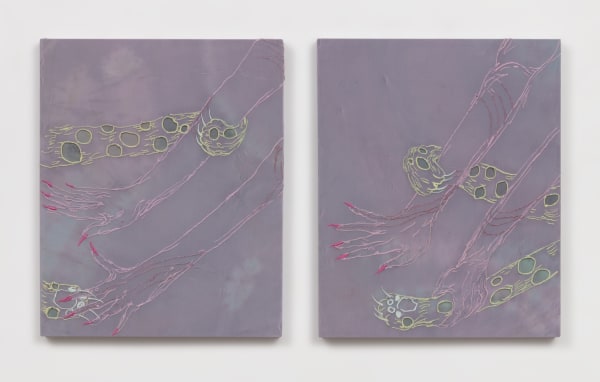Lila de Magalhaes: Cupid of Chaos
Wrapped up in the horse is a lot of human history: war, peace, hunting, domination, transport. In the modern consciousness, horses are entangled with the fantasies of unfolding femininity—the pre-pubescent girl feeling for the first time power and speed and communion between her legs. We’ve poured a lot of ourselves into horses.
In his book Body and Machines, literary theorist Mark Seltzer introduces the “double logic of prosthesis,” or the “simultaneous self-extension and self-cancellation of both the body and human agency.” ¹ At once an appendage and a wound, a horse is a psychological and physical prosthesis. It augments our interactions with the world and with our understanding of ourselves, as an archetype, a symbol, an animal of work and pleasure. In Lila de Magalhaes’s video Subterranean Tournament (2019), we follow a rider who has lost her horse facing her inherent lack. She needs a magnifying glass and a mirror to look.
There is both pleasure and danger in spreading oneself into and onto the world. If life is accumulation and assimilation, it is also projection and desire. Cupid of Chaos is a reckless abandonment to entanglement. De Magalhaes summons up fear and celebration, naughtiness and surrender, consumption and decay. Objects and animals are bestowed with the deliciousness of the very fact of living, as well as the inherent abjection in this same state of being. An embroidered sun is personified—self-mutilating or having a haircut. Is one or the other less disturbing? In this chaos, it can be both. Discomfort and self-love co-exist in the images offered up to us, like an elderly, sexy spider primping in her boudoir, like fire, water, weeds, flowers, and herbs creating a single garden.
Fur is a kind of prosthetic. We don’t have pelts of our own, so we’ve layered up with someone else’s to protect ourselves from the elements. In circular wall pieces the artist calls gardens, wool functions as a different kind of bodily expansion—a reproduction of the self not through biology, but representation and making. In an anthology on the embodied, material, technological, and metaphorical potential of the prosthetic, feminist philosopher Elizabeth Grosz asserts that, “culture can be understood as an extension, a protraction, and projection of the interior of the body itself. This is what the body gives back to the life on which it feeds and which it must destroy.” ² The fur of the animal isn’t flesh, but it’s not so far off. The animal is mostly gone from the wool, yet there is an aliveness to these gardens. Layers of colors build on and swim with each other. Different grades and slides of curls recall the follicles they sprang from. There is an alchemical energy with origins in both the animal and the artist.
Although not animal, de Magalhaes’s other materials—fabric, thread, video, dye, glaze, and clay—come imbued with their own histories, auras, and relationship to bodies, life, and time, especially that of the artist. Distinct materialities and temporalities are engaged in the creation of a world. De Magalhaes’s ceramic teeth have fallen free from a mouth and found personhood in their own right. An extension, a protraction, then a body unto itself. There is a delicate line between ripeness and putridness, food and trash, person and thing, life and death. The plasticity of being is projected onto everything—bloody gashes, cotton candy, awe in beauty, shame in repulsion, love, roses, and insects descending on a girl or a corpse.
If one horse is missing, two more are here. One bears down on an adoring girl, who looks up with blind love, blowing kisses at the object of all her affections. This love is a kind of violence in its denial of the horse’s feelings. The second stares out with a bloody eyeball, telling us: “I’m yours.”
Ana Iwataki
Lila de Magalhaes (b. 1986, Rio de Janeiro, Brazil) lives and works in Los Angeles. She holds an MFA from the University of Southern California and a BA from Glasgow School of Art, Glasgow, UK. Her recent solo and two-person exhibitions include A Soft Flea, Mutt. R, Los Angeles; Remote Control, Abode, Los Angeles; Exhibition (10), SPF15, San Diego; and Motorfruit, Blood Gallery, New York. She has appeared as well in numerous group exhibitions, including Porch Gallery, Ojai; Company Gallery, New York; Freedman Fitzpatrick, Los Angeles; ltd los angeles, Los Angeles; Steve Turner, Los Angeles, PANE Project, Milan; Julius Caesar, Chicago; and 356 Mission, Los Angeles. Cupid of Chaos is her first solo exhibition with François Ghebaly.
1 Sarah Jain quotes from Mark Seltzer’s Bodies and Machines, 1992 in “The Prosthetic Imagination: Enabling and Disabling the Prosthesis Trope,” Science, Technology, & Human Values, Vol. 24, No. 1 (Winter, 1999).
2 Grosz, Elizabeth. “Naked.” The Prosthetic Impulse: from a Posthuman Present to a Biocultural Future, Marquard Smith and Joanne Morra, eds., MIT Press, 2007, p. 192.
-
 Lila de Magalhaes, Gummy, 2019
Lila de Magalhaes, Gummy, 2019 -
 Lila de Magalhaes, Garden, 2019
Lila de Magalhaes, Garden, 2019 -
 Lila de Magalhaes, Gummy, 2019
Lila de Magalhaes, Gummy, 2019 -
 Lila de Magalhaes, Garden, 2019
Lila de Magalhaes, Garden, 2019 -
 Lila de Magalhaes, Gummy, 2019
Lila de Magalhaes, Gummy, 2019 -
 Lila de Magalhaes, Garden, 2019
Lila de Magalhaes, Garden, 2019 -
 Lila de Magalhaes, Gummy, 2019
Lila de Magalhaes, Gummy, 2019 -
 Lila de Magalhaes, Pest Control, 2019
Lila de Magalhaes, Pest Control, 2019 -
 Lila de Magalhaes, Gummy, 2019
Lila de Magalhaes, Gummy, 2019 -
 Lila de Magalhaes, Garden, 2019
Lila de Magalhaes, Garden, 2019 -
 Lila de Magalhaes, Gummy, 2019
Lila de Magalhaes, Gummy, 2019 -
 Lila de Magalhaes, Garden, 2019
Lila de Magalhaes, Garden, 2019 -
 Lila de Magalhaes, Play Pause, 2018
Lila de Magalhaes, Play Pause, 2018 -
 Lila de Magalhaes, Subterranean Tournament, 2019
Lila de Magalhaes, Subterranean Tournament, 2019















